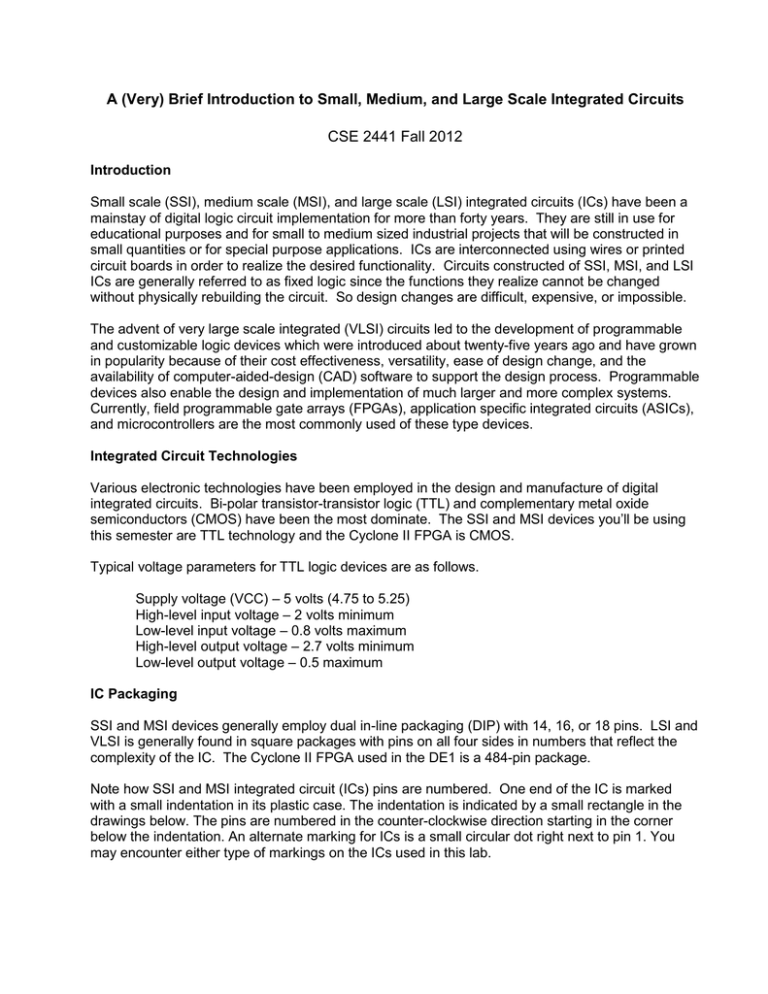(Very) Brief Introduction to Small, Medium, and Large Scale
advertisement

A (Very) Brief Introduction to Small, Medium, and Large Scale Integrated Circuits CSE 2441 Fall 2012 Introduction Small scale (SSI), medium scale (MSI), and large scale (LSI) integrated circuits (ICs) have been a mainstay of digital logic circuit implementation for more than forty years. They are still in use for educational purposes and for small to medium sized industrial projects that will be constructed in small quantities or for special purpose applications. ICs are interconnected using wires or printed circuit boards in order to realize the desired functionality. Circuits constructed of SSI, MSI, and LSI ICs are generally referred to as fixed logic since the functions they realize cannot be changed without physically rebuilding the circuit. So design changes are difficult, expensive, or impossible. The advent of very large scale integrated (VLSI) circuits led to the development of programmable and customizable logic devices which were introduced about twenty-five years ago and have grown in popularity because of their cost effectiveness, versatility, ease of design change, and the availability of computer-aided-design (CAD) software to support the design process. Programmable devices also enable the design and implementation of much larger and more complex systems. Currently, field programmable gate arrays (FPGAs), application specific integrated circuits (ASICs), and microcontrollers are the most commonly used of these type devices. Integrated Circuit Technologies Various electronic technologies have been employed in the design and manufacture of digital integrated circuits. Bi-polar transistor-transistor logic (TTL) and complementary metal oxide semiconductors (CMOS) have been the most dominate. The SSI and MSI devices you’ll be using this semester are TTL technology and the Cyclone II FPGA is CMOS. Typical voltage parameters for TTL logic devices are as follows. Supply voltage (VCC) – 5 volts (4.75 to 5.25) High-level input voltage – 2 volts minimum Low-level input voltage – 0.8 volts maximum High-level output voltage – 2.7 volts minimum Low-level output voltage – 0.5 maximum IC Packaging SSI and MSI devices generally employ dual in-line packaging (DIP) with 14, 16, or 18 pins. LSI and VLSI is generally found in square packages with pins on all four sides in numbers that reflect the complexity of the IC. The Cyclone II FPGA used in the DE1 is a 484-pin package. Note how SSI and MSI integrated circuit (ICs) pins are numbered. One end of the IC is marked with a small indentation in its plastic case. The indentation is indicated by a small rectangle in the drawings below. The pins are numbered in the counter-clockwise direction starting in the corner below the indentation. An alternate marking for ICs is a small circular dot right next to pin 1. You may encounter either type of markings on the ICs used in this lab. The numbers given to the ICs (7400, 7402, 7408 & 7432) are generic numbers. For the real ICs you will be using the part numbers have additional letters which vary from one manufacturer to another. A typical IC might be marked SN7400, or SN74LS00, or DM7400N. Many combinations exist, and often indicate special properties of an IC, but for the labs this semester you should be concerned only with the generic types. Package Layout and Pin Outs of Commonly Used SSI and MSI Digital Integrated Circuits 7400 7402 7408 7400 7404 7410 7430 7486 74138 Vcc GND 7474 PR Q Q CK D Q Q Q Q PR CLR CLR CK GND 2S 2 S U A U M M 1 B N C 1 1 C V G D 2 2 c c 0 PR Vcc 7 4 8 2 G B J J CK PR CK A Q K CLR CLR D 7420 7476 K Q S U B 4 A 4 S U CM 4 C N D 7 4 8 3 4 0 B 1 A 1 S U M A AM 3 B 33 S V c U c BM 1 2 2 2 7432 74151


